 |
You can define the following options:
- Alignment: The basic flange direction runs in normal direction of the base surface, if surface edges have been
selected as guide curve, or in normal direction of the target surface, if the guide curve is a curve segment or curve.
|
| |
 |
Patch Normal: The normals of the surface edge selected as guide define the flange direction. |
|
 |
| |
 |
Guide + Prio. Tangent: The flange direction generated from a moving frame type that is tangent to the Guide
direction and is orientated depending upon the direction chosen. |
|
 |
| |
 |
Guide + Prio. Direction: The flange direction is taken from a direction defined from the Direction field. |
|
 |
| |
 |
Moving Frame: The flange direction can be defined by a Moving Frame (see 'Moving
Frame' tab). |
|
|
| |
- Guide: Specifies the guide curve.
- Surface: If a curve is selected, the flange is created in normal direction of an individual surface.
|
| |
'Options' tab |
 |
| |
- Orientation:
- Auto: This option is only available for the Guide + Prio. Tangent and Guide + Prio. Direction
options.
You can choose to allow the definition for the orientation of the Flange to be calculated automatically via a local
Z axis.
- Direction: The flange direction can be specified manually.
|
| |
- Fillet Parameters:
- Radius: The Radius field allows the user to enter a global radius value across the full
length of the fillet.
The value is stored within the feature specification tree.
|
| |
 |
Mid Radius: Only available if 'Form Factor' is switched off.
For the middle of the arc a Mid Radius different from the Radius can be specified.
The transition quality will be preserved.
The mid radius is applied along the center line of the radius value.
The value is stored within the feature specification tree. |
|
 |
| |
 |
Form Factor: Only available if 'Mid Radius' is switched off.
The tangent length of the fillet curves is modified according to the radius value. The transitions to the original curves
remain unchanged.
Values smaller than 1 create flat fillets, values higher than 1 steep fillets.
The value is stored within the feature specification tree. |
|
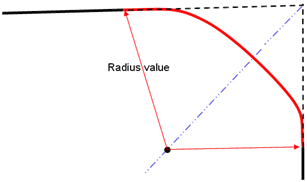 |
| |
- Continuity: There are 2 continuity settings available to the user for the resultant Fillet of the feature:
- G1 = Tangency continuity is maintained between the Fillet and support surfaces.
- G2 = Curvature continuity is maintained between the Fillet and the support surfaces.
|
| |
- Type
 Variable: This option allows to define a variable
fillet size along the guide curve length. Variable: This option allows to define a variable
fillet size along the guide curve length.
The two manipulators representing the fillet radii at each end are individually modifiable, thus creating a variable fillet
of a linear transition.
It is also possible to define alternative Radii along the guide curve at the same position as the insertion of a new manipulator. Chordal: A fillet with chordal parameterization
and constant distance across the bi-tangent lines of the fillet is created. Chordal: A fillet with chordal parameterization
and constant distance across the bi-tangent lines of the fillet is created. True Minimum Radius: Minimum radius is controlled.
Trace curves will be computed 1.5 x Mid Radius value for both G1 and G2. True Minimum Radius: Minimum radius is controlled.
Trace curves will be computed 1.5 x Mid Radius value for both G1 and G2.
When activating the icon, the option True Min. Rad. is displayed instead of Radius.
|
| |
- Flange-Parameters:
- Length: Defines the main length of the Flange.
If Individual is on, you can specify an individual length between start and end point.
- Angle: Defines the angle of the Flange with respect to the selected Alignment options.
If Individual is on, you can specify an individual angle between start and end point.
|
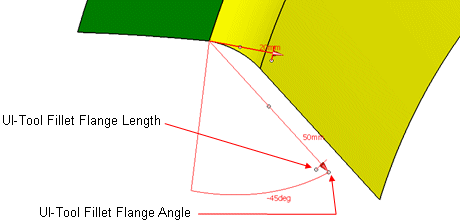 |
| |
For the options Length and Angle the following contextual menu is available:
- Change step: The values for Length and Angle can be modified by 1 mm or the specified step size. The step size
can be modified via new one.
- Measure between... : see Measuring
Distances between Geometrical Entities.
- Measure Item...: see Measuring Properties.
- Add Range: For Length and Angle, you can specify values within a range.
With this option a dialog box is activated, in which you can modify the values for the inferior and superior range. With
the option Included, the inferior and superior limit values are included.
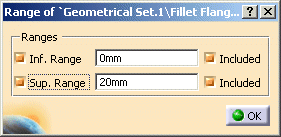
|
| |
- Options:
- Center Curve: Creates a 3D curve passing through the center of the Fillet portion of the Fillet Flange surface.
The curve element is selectable within the Fillet Flange feature node within the specification tree.
|
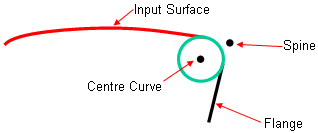 |
| |
 |
Offset: Allows to offset the Fillet portion of the Feature by a specific value. |
|
 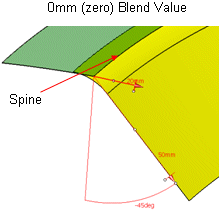
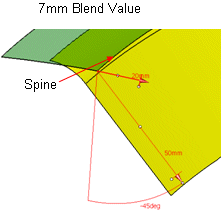 |
 |
'Advanced' tab (in ISD only) |
 |
| |
- Type:
- None: The flange is created with the specified Length.
- Connect: The flange length is limited at the surface selected with the option Reference. If
Connect is switched an, the option Length is not available.
- Shape: Type of Transition: Specifies the shape of the surface, i. e. the transition type between the individual
selected Flange sections (Default: Smooth Shape):
|
Linear Shape
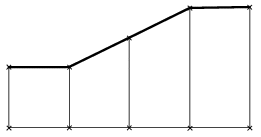
|
Local Shape
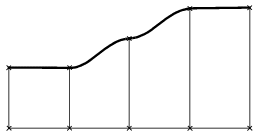
|
Smooth Shape

|
Global Shape
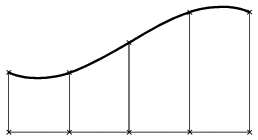
|
|
 |
See Moving Frame tab (in ISD only) |
| |
See Approximation tab |
| |
See Output tab |
| |
Click onto the 'More Info' button to display deviations and output results. |
 |
| |
- Display: Depending on the options selected, values are displayed in the graphics area.
- Deviation:
- G0, G1, G2: Displays the maximum continuity deviation of the Fillet result measured against the support
surface as a result of the approximation settings imposed.
- U+V: Display of the UV vectors of curves and surfaces.
- MFT: Display of the local coordinate system for the moving frame type.
- Output Result: See Output Result
|
| |
Manipulators and context menus
|
| |
The created flange surface can be modified as follows using the manipulators:
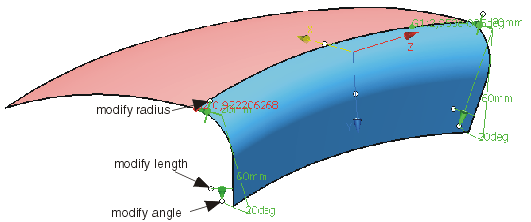
Moving the drag manipulator on the guide, you can add additional manipulators allowing to specify individual lengths and angles:
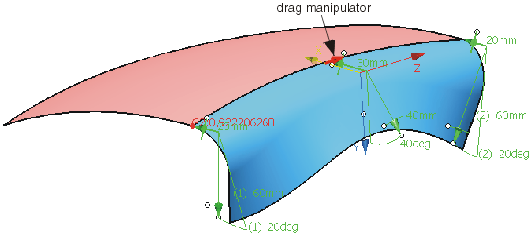
|
 |
Note: Pressing the control key allows simultaneous manipulations of length and angle. In this case,
however, individual values will be equated. |
| |
- Invert direction: Upon the selected guide curve a moving frame type manipulator is displayed. By selecting
either the 'X' (yellow) or 'Y' (blue) manipulator, the user can select which quadrant of the created flange is required.
|
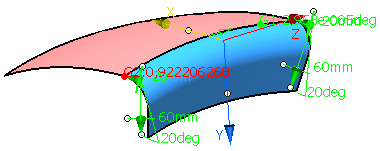 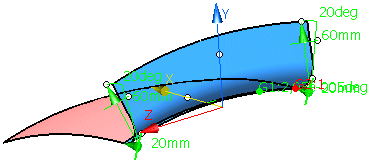 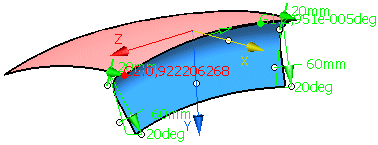 
|
| |
At the manipulator handles, you can activate with the right mouse button context menus with the following options:
- Edit Angle (for angle modification only): The dialog box 'Angle Tuner' to specify a new angle value is activated.
- Keep Point (for angle modification only): A point is created at the current position of the manipulator.
- Spread all (for angle and length modification only): The current value is assigned to all other manipulators.
- Edit Position (for additionally inserted manipulators only): Changes the manipulator position.
- Delete (for additionally inserted manipulators only): Deletes the manipulator.
At the drag manipulator, you can activate with the right mouse button a context menu with the following options:
- Edit Position: Changes the manipulator position.
- Freeze:
- Keep this point:
|
|

|
 .
.















